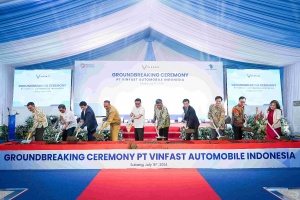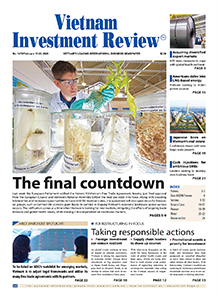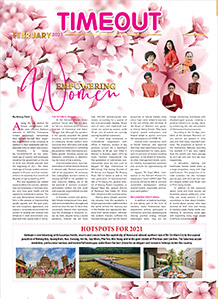Major new $760 million bridge for Hanoi to begin construction in May
The construction of the bridge will be funded by public investment, instead of the public-private partnership model as initially proposed.
 |
| Artist's impression of Tu Lien Bridge. Photo: baodautu.vn |
Tuan noted that Tu Lien Bridge is one of three key bridges besides the proposed Tran Hung Dao and Ngoc Hoi crossings that need to be built urgently to alleviate traffic congestion, accelerate infrastructure planning, and propel socioeconomic development on both sides of the Red River and within the city's districts.
"To streamline administrative procedures and expedite investment preparation and construction, the city has decided to finance Tu Lien Bridge construction through public investment," said Tuan.
Tu Lien Bridge, which will connect the Tay Ho and Dong Anh districts, is expected to be the second cable-stayed bridge in Hanoi, along with Nhat Tan Bridge.
The bridge will feature a combination of cable-stayed and twisted cable designs, with a lightweight steel frame and a main span of 1,000 metres. The distance between the piers will be 500 metres. The bridge tower will reach a height of 158 metres and will be designed to withstand a magnitude-eight earthquake.
The main piers of the bridge have been specially designed, with hopes that they will become an architectural landmark and a new symbol of Hanoi. The total estimated investment for the project is expected to surpass $760 million.
The construction of Tu Lien Bridge is expected to help ease traffic pressure on existing bridges while improving connectivity between central Hanoi and nearby localities such as Thai Nguyen and Bac Giang.
Tu Lien Bridge is one of 18 bridges over the Red River within Hanoi that have been approved in the city's master plan by the prime minister.
Currently, Hanoi has completed the construction of eight bridges; Thang Long, Chuong Duong, Vinh Tuy, Thanh Tri, Nhat Tan, Vinh Thinh, Long Bien, and Van Lang.
According to the city’s transport development plan towards 2030, Hanoi is to build an additional 10 bridges over the Red River; Tu Lien, Tran Hung Dao, Van Phuc, Hong Ha, Me So (part of Ring Road 4), the new Thang Long Bridge (Ring Road 3),, Thuong Cat, Ngoc Hoi (Ring Road 3.5), Phu Xuyen, and the already completed second phase of Vinh Tuy.
Tu Lien Bridge and its connecting roads will span approximately 11.5km. The bridge itself will be 2.9km long, with the main bridge section extending 1km. It will have six lanes for motorised vehicles, two mixed-use lanes, and two lanes for pedestrians.
As planned, Tu Lien Bridge will connect the east and west banks of the Red River, facilitating the development of the northern areas of the city in line with Hanoi’s new urban planning.
Additionally, the approach road to the Tu Lien Bridge will provide a direct connection to the Hanoi-Thai Nguyen Expressway and link to the northern section of Ring Road 3.
In a proposal submitted last October, Vingroup expressed its desire to invest in the Tu Lien Bridge development under the Build-Transfer model. Vingroup pledged to complete the venture on schedule, ensure high quality, and turn Tu Lien Bridge into a new landmark of the capital city.
Hanoi People's Committee assigned Vice Chairman Tuan to work with leading conglomerate Vingroup and China’s Pacific Construction Group to finalise investment plans last November.
 | Chinese group proposes to build Tu Lien Bridge and Hanoi Metro Prime Minister Pham Minh Chinh received leaders from some of the top Chinese infrastructure and energy development firms in Beijing on June 27, including Yan Jiehe, founder of Pacific Construction Group. |
 | Construction starts on $200 million VinFast EV assembly plant in Indonesia VinFast officially broke ground on its new electric vehicle (EV) assembly plant in Subang, West Java, Indonesia, on July 15. |
 | Hanoi greenlights investment in three major bridges across Red River Chairman of Hanoi People's Committee Tran Sy Thanh has approved the investment plan for three major bridges across the Red River to be constructed between 2025 and 2030, assigning responsibilities to the relevant units. |
What the stars mean:
★ Poor ★ ★ Promising ★★★ Good ★★★★ Very good ★★★★★ Exceptional
Related Contents
Latest News
More News
- Kolon signs $48 million airbag supply deal with Autoliv (December 15, 2025 | 18:14)
- National Assembly approves Vinh–Thanh Thuy expressway project (December 15, 2025 | 18:02)
- Quang Tri green-lights $1.59 billion LNG-fired power project (December 15, 2025 | 17:59)
- Stress laid on high-quality FDI inflows (December 15, 2025 | 11:00)
- Can Tho utilises its growth advantages (December 15, 2025 | 09:09)
- Ca Mau unlocking potential to shape a more sustainable future (December 15, 2025 | 09:02)
- Major projects to be inaugurated nationwide (December 15, 2025 | 08:00)
- MoF workshop highlights mounting concerns over ODA on-lending costs (December 12, 2025 | 16:05)
- National Assembly approves pilot mechanisms to accelerate major projects in Hanoi (December 12, 2025 | 11:29)
- Legislation gives government flexibility for loan guarantees (December 11, 2025 | 18:04)

 Tag:
Tag:



























 Mobile Version
Mobile Version